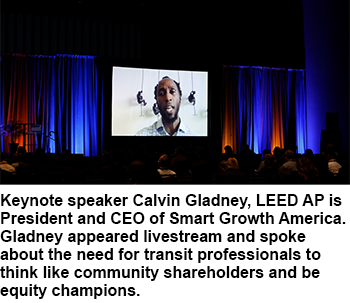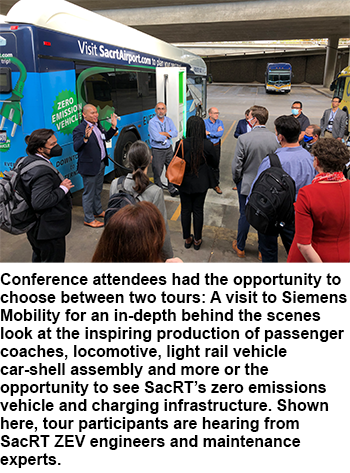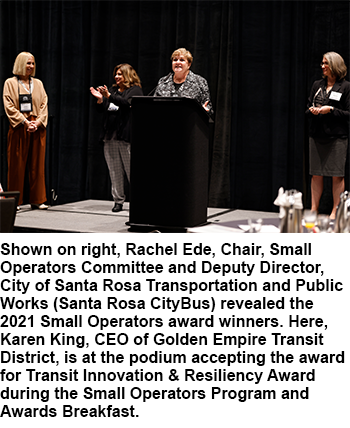With recovery in the spotlight, transit professionals reconnect in Sacramento for the 56th Annual Fall Conference & Expo, presented by Proterra.
By Stephanie Jordan
Managing Editor
Transit California
Transit professionals from across California gathered in Sacramento earlier this month for the California Transit Association’s 56th Annual Fall Conference & Expo, presented by Proterra, enjoying three days of education, collaboration, and insight at the newly renovated SAFE Credit Union Convention Center. With Embracing Change. New Era. New Vision. as the theme, the event’s speaker program featured compelling plenaries and insightful concurrent sessions.
“The road back together has not been an easy one,” said Michael Pimentel, Executive Director of the California Transit Association in his opening address. “But today, as we convene for the first time face-to-face against the backdrop of the magnificent state capitol, tomorrow feels brighter. We are here to embrace change, to learn from one another, to network and to build long-lasting relationships. Most of all, we are here to take what we have discovered from this challenging period to transform the future of public transit.” .png)
The opening general session also included welcome commentary from Sacramento Mayor Darrell Steinberg and San Francisco Municipal Transportation Agency Director of Government Affairs Association Executive Committee Chair Kate Breen; and Sacramento Regional Transit District General Manager and CEO Henry Li, the agency host of the 56th Annual Fall Conference & Expo.
A highlight of the opening session was a warm virtual welcome from California Governor Gavin Newsom, where he expressed gratitude for the public transit industry “for all that you have done to keep our state moving forward throughout the pandemic.” He went on to say how public transit agencies were able “through your actions and hard work to prove just how essential public transit service and public transit workers are to maintaining the fabric our state.”
The Governor also pledged to support the industry saying, “We are leaning in, including, by the way, moving forward on new investments.”
He concluded his address with the promise of “I’m looking forward to moving forward with each and every one of you on climate action plans for transportation infrastructure, which we know will reduce green house gas emissions and support public health. Thank all of you for the essential work you do on a day-in, day-out basis and I look forward to continuing our work together.”
Keynote Calvin Gladney
The opening keynote was Smart Growth America President and CEO Calvin Gladney, LEED AP, who encouraged the audience to re-envision and broaden their role and think of themselves as community shareholders. Gladney has a wealth of practical, hands-on experience in helping residents and leaders of towns and cities across the country sustainably revitalize neighborhoods, while ensuring that historically underserved communities are not left behind along the way.
“When you think beyond a specific project and expand your lane, you move toward becoming a community shareholder,” explained Gladney to the audience. “Become a life saver, there are lives behind the projects that you work on that are affected by the investments that you make, or don’t make.”
Gladney referenced Dangerous by Design, a national analysis of pedestrian fatalities in the county, published by his organization.
“Everything we have done to create mobility has created significant material danger for those that are walking, biking, rolling, and getting around by means other than the car,” he reported. “People of color are disproportionately represented in terms of pedestrian fatalities. According to Dangerous by Design findings, African Americans are 82 percent more likely to be hit and killed as a pedestrian than any other group. Similarly, lower income folks are also more likely to be hit by a car. This has to do with the way we design our streets, but it also has a lot to do with public transit.”
Gladney went on to say, “Getting to public transit can be fraught with peril f or people in lower income neighborhoods. These people are disproportionately dying while walking – walking to public transit in many cases. We need to invest in safer, more equitable streets.”
or people in lower income neighborhoods. These people are disproportionately dying while walking – walking to public transit in many cases. We need to invest in safer, more equitable streets.”
So what can public transit professionals do about safer streets? According to Gladney, “You can broaden your role and say to yourself, as a community shareholder, I can’t think of just the bus shelter itself, or the service, or the headways, or the buses that I have brought to the table. I should consider myself relevant to the question: How will people get to my bus stop? You can save lives by raising your hand, raising the issues, and getting involved. That is an example of broadening your role as a community shareholder.”
Equity Champion
In his presentation, Gladney also touched on policing strategies used on public transit. “We know that Black and Brown people are killed on interactions with public transit. As you envision yourself as a community shareholder, you can recognize that there is a different lived experience for members of the community who are riding public transit. And ask yourself, how do I channel their experience? How do I bring it to the decision-makers?”
Gladney expressed concerns over the disproportionate focus on eight-to-five, asking the audience to consider if the concept of “rush hour” was racist. He acknowledged that rush hour deals with the most amount of people.
“But when you think about the Black and Brown people that are service workers, they don’t have an eight-to-five. It is not equitable to put all your best resources into eight-to-five. Equity does not always equal efficiency. We need to think about our budgets and allocations or resources. Sometimes when we are trying to move away from our racist past and work on restorative justice, at some point, we have to realize we can’t just have efficiency. This is where we can partner with the federal government or state or localities to say we need more budget to allocate for equity and that may mean being 'inefficient’ with our resources.”
Toward the end of his presentation, Gladney suggested that a better way to measure true quality of life and affordability is to combine the cost of housing and transportation together to not exceed 45 percent of an area’s median income.
“We need to broaden the things we measure within the community. We measure the time it takes to get through communities; we think about speed over safety. But we should think about additional things – think about access and broader ecosystem of mobility. How does it broaden the ecosystem? Like access to jobs for those that are the most vulnerable? Or affordable housing? Or for the ones that need restorative justice?”
Insightful Presenters
On the second day’s general session, attendees heard a recorded message from U.S. Senator Alex Padilla, the first Latino to represent California in the United States Senate, that detailed the Senate’s work to deliver significant new federal investments to benefit public transportation, address climate change, and advance equity.
“I look forward to a new era of public transportation,” Senator Padilla told attendees. “We need to aim high to build a sustainable and equitable future. Working together, I know we can do it.”
Upon the conclusion of Senator Padilla’s comments, Breen acknowledged, “We are really lucky to have such incredible transit champions both here in Sacramento, as well as in Washington, DC.”
Following Senator Padilla, the next session was Mind the Gap: Addressing Transit’s Workforce Needs, featuring moderator Karen Philbrick, PhD, who is Executive Director of the Mineta Transportation Institute, and a panel of industry experts, including: Shrayas Jatkar, Interagency Policy Specialist (Equity, Climate, and Jobs), California Workforce Development Board; Beverly A. Scott, Ph.D., Founder, Introducing Youth to American Infrastructure, Inc. (“Iyai”); Lauren Skiver, CEO and General Manager, SunLine Transit Agency; and Matthew Tucker, Executive Director, North County Transit District. Be sure to read coverage of this session in this edition of Transit California.
Presentations from the main conference stage concluded with an illuminating closing keynote from change agent and Founder and CEO of the Thrivance Group, Dr. Destiny Thomas, who explored the inequities embedded in our transportation infrastructure and services, as well as the opportunity for healing through community engagement. For highlights of the audience questions and the interview portion of the presentation between Dr. Thomas and Alva Carrasco, VP Transit and Rail National Business Line, West Region Market, WSP and Vice Chair of the Association’s IDEA Task Force, read On Board With…Dr. Destiny Thomas found in this edition of Transit California.
Concurrent Sessions
With five educational tracks, attendees customized their conference experience by selecting from 20 sessions that were the most valuable to them. Tracks included Policy, Innovation and Customer Experience; Maintenance; Management and Leadership; Marketing and Communications; and Operations. The sessions were designed to include both formal presentations and to invite attendee participation through question and answer segments or interactive activities. The concurrent sessions assembled panels of transit experts and knowledgeable peers with many sessions focused on public transit service post-pandemic and the sharing of solutions that are being implemented to address today’s challenges.
Small Operators
The Small Operators Program and Awards Breakfast opened with a relevant for-the-times presentation by researcher, lecturer, consultant, and author Leah Weiss, PhD, MSW. Her early morning virtual presentation, Overcome Burnout & Build Resilience Anchoring in Your Purpose, acknowledged that in a stressed workforce quality of work suffers, relationships suffer, health suffers, and organizations suffer. 
Dr. Weiss reviewed how burnout is an occupational phenomenon that is composed of three components: Emotional exhaustion, depersonalization, and reduced personal efficacy. She also noted that burnout is on a spectrum and leads to increased incivility.
“Once we understand the mindsets that need to shift, we can be more open and attune to notice the symptoms of burnout,” explained Dr. Weiss. “We need to build individual and team resilience to address burnout. One of the greatest weapons against burnout that we have is our ability to find purpose. This can be helpful at all levels of an organization – individual, team and organizational.”
Dr. Weiss shared that, “Over 50 percent of people can’t answer the question: What are you supposed to be doing at work and why. No wonder they aren’t engaged!”
Purpose, she defined, is a far-reaching, steady goal; something personally meaningful that also reaches out into the world. “By having a sense of purpose, we can find a sense of priority, clarity, and collaborative spirit. All of this allows us to improve resilience and endurance, while improving performance and creativity.”
After Dr. Weiss shared a short Q & A with Rachel Ede, Chair of the Association’s Small Operators Committee and Deputy Director of Santa Rosa Transportation and Public Works (Santa Rosa CityBus), Ede presented the Small Operators Awards for 2021.
“It is my honor to present four awards today,” said Ede. “Making award selections is always a difficult task, but this is particularly true coming off the last 18 months, when so many operators have done truly remarkable work to serve their communities through the pandemic. Small operators have shown tremendous dedication; we have been innovators, creative problem solvers, and have continually evolved strategies to meet the day’s challenges and take advantage of new opportunities to improve our services. All this has made it very difficult to select just one awardee per category.”
 The difficult task of selecting award winners falls to the Small Operators Awards Nomination Subcommittee. This year the awardees are:
The difficult task of selecting award winners falls to the Small Operators Awards Nomination Subcommittee. This year the awardees are:
- Transit Innovation & Resiliency Award: Golden Empire Transit District
- Transit Agency of the Year Award: Antelope Valley Transit Authority
- Distinguished Service Award: Steven P. Brown, Gold Coast Transit District
- Transit Professional of the Year Award: Jeanne Krieg, Tri Delta Transit
Election of Officers
Also part of the conference proceedings was the installation of the Association’s 2021-2023 Executive Committee, as well as the election of officers for the new two-year term. Karen King, CEO of Golden Empire Transit District, was elected as the new Chair of the committee, and Sharon Cooney, CEO of San Diego Metropolitan Transit System was elected as Vice Chair.
In taking the stage, King acknowledged former Chair Kate Breen, saying: “Thank you, Kate. You have been a tremendous leader during this pandemic period and it is a great privilege for me to be able to take the reins from you: a trailblazer in our industry. King went on to talk about the Association’s 2022 work program describing the key goals as being very ambitious with a focus on “reforms to the Transit Development Act, the reduction in the cost of zero emission vehicle deployment, tackling the homeless issue, and shaping the next generation of transit leaders with innovative workforce development efforts, and through it all,” she said, “We will make certain that transit equity, racial, and social justice are at the core of what we do.”
King ended by encouraging Association members to lean in, stating, “It will require tremendous hard work from all of you. I am asking every one of you to stay engaged, and participate actively in the Association, as we move forward with these challenging times.”
Thank You
The 56th Annual Fall Conference & Expo is the result of many hands working together. The Association thanks agency host Sacramento Regional Transit District, as well as the conference presenting sponsor, Proterra, and the many sponsors and exhibitors who helped to make possible the Association’s premier annual event. In addition, the Association’s deep gratitude goes to the 2021 Program and Conference Committee, whose hard work and dedication produced an amazing program.
Recordings of the California Transit Association’s 56th Annual Fall Conference & Expo plenary sessions, plus 10 concurrent educational sessions, are now available to all in-person and virtual attendees via the Association’s conference app and web platform: Socio.
Ontario in 2022
Please save the dates of November 16-18, 2022 to come to the Ontario Convention Center and Doubletree by Hilton Hotel in Ontario and look to the Association’s website for evolving details for the California Transit Association’s 57th Annual Fall Conference & Expo, hosted by Omnitrans.